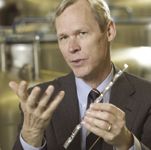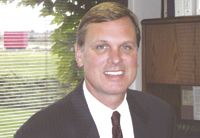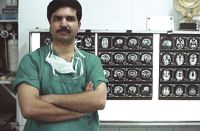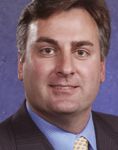Unleashing the Promise
Recently developed technologies produce clinical quality cells in as few as12 days. Culturing cells in petri dishes can take a month or more.
Two Months Before Former President Reagan died, Nancy Reagan delivered a grim yet hopeful message to an audience at a Juvenile Diabetes fundraiser. Referring to her husband's long battle with Alzheimer's disease, Mrs. Reagan said, "Ronnie's long journey has taken him to a distant place where I can no longer reach him. I'm determined to do what I can to save other families from this pain, and now science has presented us with a hope called stem cell research." Her remarks garnered a great deal of attention and, when the former president died, the public fervor around the debate escalated.
Continued Controversy
The heat in this discussion was first ignited in 2001, when President Bush limited federally funded embryonic stem cell research to stem cell lines that were already in existence. At that time, 78 cell lines met the requirements, yet only 19 of those lines were available for study. Since then, demand for access to embryonic stem cell lines has swelled, prompting universities such as Harvard, Stanford, Massachusetts Institute of Technology, and the Universities of Wisconsin and Minnesota to use private money to pursue research initiatives.

David Beck, PhD, President, Coriell Institute
Also in 2001, David Beck, PhD, president of the Camden, New Jersey–based Coriell Institute for Medical Research, which houses the largest repository of cell cultures in the world, made a prescient remark: "Much of the controversy regarding embryonic stem-cell research will go away, because we're learning so much about stem cell biology." Beck stands by his prediction. "There will always be some controversy of course," he says now. "However, in time the arguments framed by Nancy Reagan will prevail." Ella de Trizio, a partner in Princeton, New Jersey–based Dechert, which provides venture capital financing for life sciences companies, shares Beck's enthusiasm. "It's important to remember that in addition to getting past the political stigma, developing stem cell-based therapies is really no different than any other biotech endeavor. You have to take the long view," she says.
Although Beck says there has been noteworthy progress in embryonic research, he cautions that there are challenges. "With all stem cells, there are issues that we need to understand better in order to harvest their potential," he says. He also notes that embryonic stem cells are harder to work with than previously believed because "they tend to form structures that are not completely within our control."
New research published in Nature Medicine on January 23 highlights yet another challenge: The cell lines currently approved for study under federal funding contain a non-human molecule, the sialic acid Neu5Gc, which elicits an immune response in humans. "The problem is that these human embryonic stem cell lines have been grown in such a way that they are contaminated by animal protein and cannot be used for human therapeutic purposes," Beck explains.
Meanwhile, adult stem cell research is pushing the science ahead at a steady clip. Beck cites cancer research as a relevant analogy: "In the nineteen seventies Richard Nixon declared war on cancer. Everyone expected an instant cure, but it wasn't like that. Though we haven't cured cancer, we've learned a lot about basic biology, cells, and genes. We've made substantial inroads against cancer. And these applications are coming to market in a deliberate and precise way." Beck predicts that stem cell-based therapies will also come to market in a systematic fashion.
In April 2004, 204 members of the House of Representatives, including 36 Republicans, signed a letter urging President Bush to rethink the restrictions on embryonic stem cell research, suggesting that hundreds of thousands of embryos stored in in-vitro fertilization (IVF) clinics could be used to advance embryonic stem cell research.

R. Douglas Armstrong, PhD, chairman and CEO, Aastrom Biosciences
Despite the ethical, moral, and political dimensions that currently frame discussions about stem cell research, there are scientists, business professionals, and investors who are solely focused on the scientific promise that one day the most recalcitrant diseases will be addressed by replacing diseased cells with stem cells that can be coaxed into reviving health and functionality. Stem cell-based therapeutics that enter clinical trials within the next five years will likely enter clinical practice in the next 10 years. Here's a look at a few of the companies that will help make that happen.
Aastrom Biosciences
This Ann Arbor, Michigan–based company specializes in the development of proprietary adult stem cell-based products intended for tissue regeneration and cell therapy. Aastrom Biosciences' efforts, several of which are currently in clinical trials, use a diversified set of tissue repair cells (TRCs). TRCs are produced in the company's patented cell production platform, the AastromReplicell System (ARS), which was developed to address the issue of cell yield so that the company could grow large quantities of highly robust human cells, including adult stem cells and progenitor cells, outside of the human body.
This automated process, based on single-pass perfusion, creates an environment in which the medium only washes over the cells once, mimicking cell growth in the body. Aastrom's ARS is currently being used in 16 labs under licensing and joint collaboration agreements.

Search for a Perfect Union
Becky Anderson, who works in Aastrom's investor relations department says, "This technology has the potential to become the system of choice amongst researchers. It takes over a month to culture cells in a Petri dish, but using our system, we can produce clinical quantities of cells in as few as twelve days." CEO R. Douglas Armstrong, PhD, helped create the business plan to bring this technology, developed at the University of Michigan in 1989, into the clinic, where it is being used in various studies.
Transplants Andrew L. Pecora, MD, chairman and director of the Cancer Center at Hackensack University Medical Center in New Jersey, has used ARS to successfully treat people with leukemia. One notable patient was an overweight diabetic who received umbilical cord blood-derived stem cells during a transplant procedure for leukemia. Pecora used ARS to increase the number of available cells threefold. The engraftment was successful and nine years later, the patient is alive and well. "Replicell makes the engraftment more robust," Pecora says. "It holds promise that by expanding certain subsets of cells there may be clinical benefit, but you have to prove these cells can do what you want them to do."
Bone grafts Aastrom's TRCs are a mixture of bone marrow-derived stem cells and progenitor cells. Chief among the company's portfolio is its orthopedic product for severe fractures, currently in Phase I/II clinical trials in the United States and Europe for bone graft applications.
Aastrom is partnered with the Musculoskeletal Transplant Foundation, the largest producer of allograft tissue products for orthopedic surgery. More than one million patients a year with severe non-healing fractures undergo bone grafting, a painful and often debilitating process that removes bone marrow from a patient's hip and autografts it to the fracture site. Using ARS, surgeons can extract a minimal amount of bone marrow containing key progenitor and stem cells, then replicate these cells. The next step is to combine TRCs with a glue-like matrix, pack the admixture into the fracture site, and let the cells go to work.
So far, the safety and efficacy data of more than 175 clinical patients has been positive, and TRCs have also been successful in a compassionate-use case. In a baby diagnosed with infantile hypophosphatasia, a genetic bone disease with a 50 percent mortality rate, TRCs generated healthy bone in the now seven-year-old girl. Aastrom anticipates completing some of its clinical trials by the end of 2006. A spokesperson for the company, Kris Maly, says, "Pending acceptable results, Aastrom's TRC product for fractures could move into the marketplace in calendar year two thousand six." The company also is developing TRC products for vascular regeneration applications.
Financial status Aastrom has a sufficient amount of cash ($35 million, based on December 2004 pro forma results) to ensure coverage of operational and clinical costs through 2006. The company has also been vigilant about patenting its processes, devices, and clinical systems. "The potential market size for adult stem cell–based therapeutics is enormous. We have chosen to initially focus on the orthopedics and vascular markets," Anderson says.
Celfcure
Ajay Bakshi, MD, president of the biotech start-up Celfcure, is an experienced neurosurgeon, instructor, and faculty researcher at the Drexel University College of Medicine in Philadelphia. Much of his research focuses on using a patient's own stem cells to treat trauma, such as spinal cord and head injuries, and stroke.

Chris Calhoun, CEO, MacroPore Biosurgery
Winning science In March 2004, Bakshi and his team took first place for best venture in the Babcock Elevator Competition at Wake Forest University School of Management. Then the following month, the team placed second in the highly competitive Wharton Business Plan competition. These accolades are based on sound science. Bakshi has developed a therapeutic system called Manipulated Autologous Stem Cell Therapy (MAST), which works by harvesting stem cells from patients' bodies, culturing and loading them with drugs in the laboratory, then re-transplanting them back to the patient for therapy.
According to Bakshi, "The MAST model is based on bridging the gap between scientific research labs, where cell culturing is traditionally handled, and hospitals, where clinical procedures take place." Bakshi's prize-winning process is not dependent on isolation of stem cells. Rather, using a minimally invasive procedure, Bakshi removes bone marrow from a patient's groin, expands the cells using the Aastrom's ARS and enhances them with nanoparticles loaded with drugs to achieve sustained drug release.
Into the clinic Bakshi is currently filing patents for the procedures and anticipates initiation of clinical trials in 2005. He stresses that the most important issue for him is not the strength of his intellectual property portfolio, but the biological soundness of the procedure. "Brain tissue is very sensitive, so the ability to use autologous stem cells is a big deal in central nervous system [CNS] transplantation," Bakshi says. "Using the lumbar puncture technique and injecting the cells into the cerebral spinal fluid allows the cells to migrate throughout the CNS and hone in on injured areas." At press time, Celfcure had more than $1 million in grants, including university and state support. "I see Celfcure diversifying into various areas of CNS and spinal injuries, including head injury and neonatal hypoxia," Bakshi says.

Stem Cell Primer
Business model Celfcure recently entered into a collaboration with Thomas Jefferson Hospital, the largest spinal cord injury center in the United States. "In the field of stem cell-based therapeutic development, one of the problems is that there isn't a model to make money from stem cell-based therapies," Bakshi says. "But I argue that if the science is sound, you can make money. Celfcure will make money by selling a service, rather than selling cells. It's a more robust business model."
BioE
In May 2004, St. Paul, Minnesota–based BioE, a development stage biotech, announced a significant breakthrough in stem cell research. The company, which develops antibody-based diagnostic and therapeutic technologies, isolated and defined a unique population of stem cells with properties that distinguish them from embryonic hematopoietic (blood-forming) cells and bone marrow-derived adult stem cells, as well as other multipotential adult progenitor cells. In the course of their research, BioE scientists discovered that these cells, called multilineage progenitor cells (MLPCs), demonstrate self-renewal capabilities as well as the ability to expand exponentially and differentiate into a wide variety of tissue types, including bone, nerve, and muscle—a range much more extensive for adult stem cells than previously thought.
Umbilical cord blood These cells were isolated from umbilical cord blood, and such blood is particularly advantageous because of its newness. Studies show that MLPCs have the plasticity to generate into adipocytes (fat cells), as well as osteogenic (bone-forming), mesenchymal (stromal cells found in bone marrow), and neural cells. From a clinical standpoint, this is advantageous, especially considering that the range of differentiation with bone marrow tends to be limited.

The Select Few
One year after BioE shared its news about MLPCs, they announced an even more significant development: cloned adult stem-cell lines that are similar in many ways to embryonic stem-cell lines. These cloned stem cells are derived from single-cell umbilical cord blood MLPCs and will soon be available for pharmaceutical R&D applications. "We're growing up these cells and will offer genetically characterized cell lines to researchers by the end of June 2005," says Mike Haider, BioE's president and CEO.
Despite their remarkable plasticity, MLPCs are normal cells. This means that, although they do not have some of the downsides of aberrant embryonic stem cells, they eventually die. However, they can continually be re-cloned. In fact, at this moment, BioE has developed more than 50 individual cell lines, each of which is capable of reproducing hundreds of millions of cloned cells.
Processing system At the core of BioE's research efforts is its proprietary antibody-based cell-processing technology, the patent-pending PrepaCyte System. "This product is on track to become the first FDA-compliant cell-separation product of its kind," Haider says. It may also be the key to unlocking two major challenges associated with stem cells, yield and stem cell identification. This system is designed to facilitate high-yield recoveries of MLPCs, and hematopoietic and non-hematopoietic cells from umbilical cord blood.
Here's how it works: PrepaCyte causes unwanted cells to settle to the bottom of the container, leaving desired cells in the upper fraction of the solution. This process allows stem cells to be easily removed for further processing before therapeutic use in humans, and it also results in increased quantities and higher purity of cells that retain their innate cellular functionality. (See "The Select Few".)
BioE's cell-separation technology is unique in that it is a biological process based on antibody-based negative selection, so there is no equipment or machinery involved. It all comes down to a solution full of monoclonal antibodies, which stimulate certain cells in the blood to express certain adhesion molecules on their surface.
Haider uses the "needle in a haystack" metaphor to clarify the elegance of this process. "This is a completely closed-bag system that promotes total stability. In essence, you get rid of the hay without touching the needle," he says. Distinct advantages are volume reduction, cost-savings, structural stability, and cell-selection specificity for therapeutic uses, such as transplantation. In addition, working with an FDA-compliant cell-processing system makes it easier to commercialize stem cell-based applications and facilitate therapeutic use. "If the tools are FDA-compliant when a particular therapy becomes part of the standard of care, it's a much smoother transition for the entity that is marketing or delivering the therapy," Haider says.

Chris Calhoun, CEO, MacroPore Biosurgery
Antibodies BioE's diagnostic technology also relies on antibodies. In the diagnostic platform, antibodies are used to detect both members of a binding pair, such as an immune complex, to facilitate early diagnosis. Of particular interest is their Alzheimer's disease (AD) diagnostic process. "Post-mortem analysis shows that free iron in the brain is very toxic," Haider says. "Our AD diagnostic is based on identifying the presence of the iron-regulatory protein 2 gene [IRP-2] in the brain. The goal is to develop a definitive diagnostic that could be implemented way before symptoms develop."
NIH has committed a $6.5 million grant to fund research for BioE's diagnostic, and there is currently a five-year, double-blind multicenter study taking place at Loma Linda Medical Center in California. BioE is well positioned to continue its fast-paced growth. In addition to grant funding, the company has just completed an $8.3 million round of private funding, bringing total funding since inception to $22 million—all from angel investors.
MacroPore BioSurgery
The stem cell-based research efforts of MacroPore BioSurgery, a San Diego-based life science company that discovers and develops regenerative medicines that depend on fat. The company has two platforms, regenerative cell technology and bioresorbable polymer implants for orthopedics and spinal applications (distributed through Medtronic Sofamor Danek). MacroPore's development efforts are aimed at harnessing the potential of adipose derived adult stem cells (ADCs) to develop applications for heart disease, bone and disc regeneration, and fat tissue for cosmetic and reconstructive purposes.
Cell quantity "There is a fundamental difference in our approach," says CEO Chris Calhoun. "It all comes down to the amount of available cells. Stem cells are very rare and the older we get the rarer they become. So we need to isolate them and regenerate them. Cell culturing is hard on cells and bad for cells. The FDA is working on how to regulate cell cultures. So, for example, if you extract one hundred cubic centimeters [ccs] of bone marrow, you get about five thousand stem cells. But in adipose tissue there is a substantial reservoir of stem cells. In one hundred ccs of ADC we get about five hundred thousand stem cells. We avoid all the culturing, while saving money and time. We can provide a significant number of ADCs in real-time."
Cell cocktail Adipose-derived cells are really an agglomeration of various cell types, including stem cells, angiogenic cells (cells that promote blood vessel growth), and cells useful for combating apoptosis (programmed cell death). Calhoun suggests that this cell cocktail could benefit patients who have heart attacks. After the fat is separated from the stem cells using MacoPore's proprietary filtration system, the leftover cells would function as cardiomyocytes (heart muscle cells), which do not normally regenerate in adults, and also promote angiogenesis as a way to promote blood flow to the region. Normally when heart muscle is damaged during a heart attack, the functional heart muscle is replaced with nonfunctional scar tissue, and even if the patient recovers, heart functionality and overall well-being decrease.
Healing from a heart attack Statistics indicate that 1.2 million people had heart attacks in 2004. Based on the MacroPore model, individuals who have heart attacks could potentially benefit from a process called Cellect, which Calhoun says, "fits into the current clinical paradigm." Traditionally, when a patient comes to the emergency room after having a heart attack, the patient is catheterized to undergo a dye injection process so the doctors can find the blockages. Then the patient is stented and de-catheterized. Calhoun suggests that Cellect can help the patient heal better.
"During the catheterization process, we would take one to two hundred ccs of fat and filter it through the MacroPore system," he says. "Then we would inject the cell cocktail right into the catheter, allowing the healing cells to migrate to the defect site. Animal studies in pigs provide evidence that when you can regenerate the heart cells immediately, healing is permanent. After damage to the heart, there is a race between regeneration and scarring. Heart attacks begin the process of degenerative heart disease. We want to stop it at the source and salvage the muscle."
So far, all of the early efficacy, safety, and tolerability data are positive. In fact, this model was validated in a recent study using bone marrow-derived stem cells. In a double-blind study (BOOST) published in the Lancet in 2004, 60 patients who had been treated for heart attacks were randomized to standard-of-care treatment or injected with bone marrow-derived stem and progenitor cells. After six months, patients who received stem and progenitor cells had significantly better heart function than the standard-treatment patients.
Financial status Calhoun characterizes MacroPore's intellectual property portfolio as "very aggressive." The company derives income from its bioresorbable spine and orthopedic devices as well as its complementary bioresorbable thin-film products. Its products and relationships in this niche are so strong that the company has been able to shore up cash reserves through strategic sales of non-core assets. As of March 2004, MacroPore had $15.13 million in cash. In May 2004, it announced the sale of part of its bioresorbable thin-film product line for a $7 million payment in 2004, followed by a $2 million payment in 2005.
MacroPore will retain distribution rights in Japan, which they licensed to Senko Medical Training Company for $3 million plus minimum purchase requirements and royalties. The company is also partnered with Medtronic Sofamor Danek for the co-development, marketing, and global distribution of their spinal/reconstructive implants. In addition, MacoPore received $100,000 in grants during the first quarter of 2004 and anticipates another $850,000 in NIH funds for Phase II research.
Public Funding
Although the companies featured in this article develop adult stem cell-based therapeutics, commitment to embryonic stem cell research is not waning. California and New Jersey are at the forefront of movements to provide state support for embryonic stem cell research. In late 2004, California voters approved $3 billion in state funding for stem cell research. And during his term as New Jersey governor, James McGreevey allocated $11.5 million in funding for the New Jersey Stem Cell Institute, which could spawn corporate spin-offs and viable investment and strategic partnership opportunities.
The Coriell Institute, according to president Beck, is discussing a potential collaboration with Technion (Haifa, Israel), recognized for its work with embryonic stem cells. Dechert's De Trista cites the government-funded embryonic stem cell research taking place in the United Kingdom, Singapore, and Sweden as worthy of consideration. "Singapore is even encouraging public and privately funded companies to set up shop in their five-hundred-million dollar Biopolis Laboratory."
Clearly, companies engaged in the development of regenerative medical technologies are serious about bringing their stem cell-based products and services to the market in the near future. At this point, although stem cell-based applications are not being applied with alchemical precision, they are being refined and their clinical utilization is increasing. Beck predicts, "We will live to see the day when stem cell therapy becomes part of routine medical care."
Nicole Gray, MS, works in pharmaceutical marketing communications and writes for consumer publications. She can be reached at (917) 319-4046 or nicole@home0.com.

Addressing Disparities in Psoriasis Trials: Takeda's Strategies for Inclusivity in Clinical Research
April 14th 2025LaShell Robinson, Head of Global Feasibility and Trial Equity at Takeda, speaks about the company's strategies to engage patients in underrepresented populations in its phase III psoriasis trials.
Beyond the Prescription: Pharma's Role in Digital Health Conversations
April 1st 2025Join us for an insightful conversation with Jennifer Harakal, Head of Regulatory Affairs at Canopy Life Sciences, as we unpack the evolving intersection of social media and healthcare decisions. Discover how pharmaceutical companies can navigate regulatory challenges while meaningfully engaging with consumers in digital spaces. Jennifer shares expert strategies for responsible marketing, working with influencers, and creating educational content that bridges the gap between patients and healthcare providers. A must-listen for pharma marketers looking to build trust and compliance in today's social media landscape.